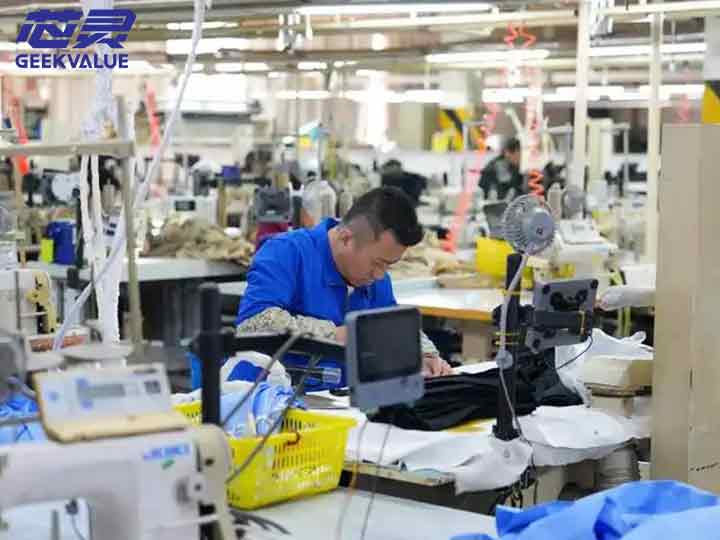Zhejiang Online News, February 18 (Intern reporter Chen Zhuoyu) After the fifteenth day of the first lunar month, the Hanbo clothing smart factory in Xiaoshan District, Hangzhou City pressed the "fast forward button" for production. On February 17, in Hanbo's large garment manufacturing workshop, cutting, sewing, nailing, ironing... each process was busy and orderly, and the workers were full of energy and made efforts to sprint for a "good start" in the first quarter.
Unlike traditional garment workshops, in this digital workshop, there is also a special "friend" accompanying the workers-Hubble Smart Cloud. This digital system developed by Hanbo itself, by "connecting" sewing machines to the Internet, collects the entire production process, makes production traceable and fragmented, realizes the visualization of production capacity and process flow, and reduces the number of workers while improving product quality and efficiency, so that workers' income increases by more than 10%.

In the workshop, a group of super-large HD screens are very eye-catching, with real-time data such as "today's output", "first-time qualified rate" and "production task volume" scrolling on the screen, so that the entire production process and real-time production situation are clear at a glance. "Through the construction of smart factories, all data in the manufacturing process can be truly perceived, and the efficiency of each worker and each device is very clear. We can know which line has excess capacity and can jump in line to add new orders. We can accurately calculate the defective rate and even find out which process has problems." Shen Jian, head of Hanbo's digital transformation, introduced that after the Hanbo Clothing Smart Factory was put into production, the defective rate was reduced by more than 20%, the production efficiency was increased by more than 30%, and the energy cost was reduced by more than 15%.
In the sewing production line, the reporter found that every worker had a Pad at his workstation. Yang Yuanmei, the leader of the inspection team, was checking the sewing of the product. She swiped an IC card gently, and the details required for each order all "jumped" out on the Pad. Yang Yuanmei and her husband have worked at Hanbo for 21 years. One is a sewing worker and the other is a big ironer. The couple witnessed the transformation and development of Hanbo. She said, "We used to keep accounts manually. We couldn't remember so many details of categories without a notebook, and it took time to turn the pages. With Hubble Smart Cloud, we can save a lot of trouble and labor, and the labor efficiency is greatly improved." Li Wen, Hanbo's information product manager, told reporters that the Pad is used to publish tasks and collect production information, telling him what the current work tasks are. Employees can clearly see their output, working hours, and wages on the Pad. "If a sewing machine is equipped with Hubble Cloud's smart terminal sensor, the working status and startup efficiency of the sewing machine will be reflected in real time on the Pad and TV board of the management terminal. The IC card is connected to the entire production process through RFID, and the order production progress, efficiency, and quality status will be fed back in real time, which is convenient for online management." "Digitalization has penetrated into every workshop of Hanbo." Wang Juncheng, an IE engineer of Hanbo, introduced that Hanbo had already transformed to digitalization more than 10 years ago. In 2020, Hanbo took the lead in developing Hubble Smart Cloud to build a comprehensive empowerment platform for the complete intelligent production chain in China. By using the Internet of Things technology and data visualization monitoring technology of production equipment, it has realized the full-process data intelligent analysis and management decision-making of personnel, equipment and materials.
In the Hanbo workshop, digital intelligent scenes are presented everywhere. Small robots are busy shuttling on the designated routes, and "classify" the fabrics to the designated workstations with the highest efficiency.
In front of the automatic template ironing belt, the workers put the fabrics into the templates according to the modules shown. In less than a minute, the machine replaces manual sewing. After one step is completed, the fabrics follow the robot to the next production line.
One-button start, fully automatic operation, the complex bag opening process becomes simple and easy because of the fully automatic bag opening machine. In just 30 seconds, a pocket is opened, the seams are flat, symmetrical and beautiful, and the efficiency is more than doubled compared with the previous ordinary flat car bag opening.
Not only in the sewing area, Hanbo clothing designers have also entered into intense work. The first thing designer David said when he saw the reporter was: "There are still 9 customers to connect with. It's really busy today!"
"This is the 2025 spring and summer series of products we developed for a certain brand..." Following the direction of David's finger, exquisite women's clothing came into view, and the fashion contained the high-end positioning of Hanbo women's clothing. The fingertips gently touched the sleeves, and the fine and shining beads sewn by heavy work set off the designer's ingenious ideas. "These clothes are newly developed new products, waiting for mass production to enter international markets such as Europe and the United States."
David said frankly that he would go deep into the factory every day, walk to the workers, and pay attention to the entire production process of ready-made clothes. He lamented that Hanbo's digital production made him more confident in his design position and full of expectations for Hanbo's future.
Hanbo is continuing to make efforts on the road of digital factory upgrades. Li Wen introduced that the factory will carry out intelligent upgrades every year. This year, it will focus on improving new application scenarios such as long-distance reading and writing sensing, helping to collect production line processes, and better empowering traditional manufacturing.
By "connecting" sewing machines to the Internet, traditional clothing manufacturing is being subverted. As one of the largest women's clothing manufacturers in China, Hanbo Group is riding the era of industrial Internet and, with the surging wave of digital reform, is pushing China's textile and garment industry towards a broader blue ocean.


